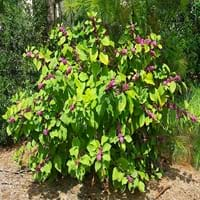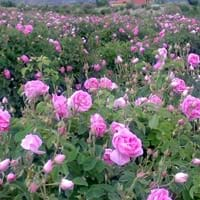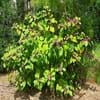Life Span
Perennial
Perennial
Type
Shrub
Flowering Plants, Ornamental Plants, Perennial
Origin
Southeastern United States, South-Central United States
Hybrid origin
Types
Not Available
Summer Damasks, Autumn Damasks
Number of Varieties
Not Available
Habitat
bottomlands, Coastal Regions, Moist woods, pine woods, Slopes, Swamps, Thickets, Woods
gardens
USDA Hardiness Zone
6-11
Not Available
AHS Heat Zone
12-1
Not Available
Sunset Zone
3a, 3b, 4, 5, 6, 7, 8, 9, 14, 15, 16, 17, 18, 19, 20, 21, 22, 23, 24
Not Available
Habit
Arching/Fountain-shaped
Clump-Forming
Flower Color
Pink, Lavender
Pink
Flower Color Modifier
Not Available
Bicolor
Fruit Color
Purple, White
Non Fruiting Plant
Leaf Color in Spring
Light Green
Green, Gray Green
Leaf Color in Summer
Light Green
Dark Green, Green
Leaf Color in Fall
Yellow green, Tan
Green, Gray Green
Leaf Color in Winter
Not Available
Dark Green, Green
Leaf Shape
Elliptic
Pinnate
Plant Season
Spring, Summer, Fall
Spring, Summer, Fall
Sunlight
Full Sun, Partial Sun, Partial shade
Full Sun, Partial Sun
Growth Rate
Medium
Medium
Type of Soil
Clay, Loam, Sand
Loam, Sand
The pH of Soil
Acidic, Neutral
Acidic, Neutral
Soil Drainage
Well drained
Well drained
Bloom Time
Early Summer, Summer, Late Summer
Spring, Late Spring, Early Summer, Summer, Late Summer, Early Fall, Fall
Repeat Bloomer
No
Not Available
Tolerances
Not Available
Drought
Where to Plant?
Ground, Pot
Container, Ground, Pot
How to Plant?
Cuttings, Seedlings
Cuttings
Plant Maintenance
Medium
Medium
Watering Requirements
Medium
Average Water Needs
In Summer
Lots of watering
Lots of watering
In Spring
Moderate
Moderate
In Winter
Average Water
Average Water
Soil pH
Acidic, Neutral
Acidic, Neutral
Soil Type
Clay, Loam, Sand
Loam, Sand
Soil Drainage Capacity
Well drained
Well drained
Sun Exposure
Full Sun, Partial Sun, Partial shade
Full Sun, Partial Sun
Pruning
No need to prune
Remove damaged leaves, Remove dead branches, Remove dead leaves
Fertilizers
All-Purpose Liquid Fertilizer, fertilize in spring, Use a fertilizer ratio of 16-4-8
All-Purpose Liquid Fertilizer
Pests and Diseases
Red blotch
Beetles, Black Spot, Caterpillars, Downy mildew, Mosaic viruses, Powdery mildew, Rust, Scale insects, Thripes
Plant Tolerance
Not Available
Drought
Flower Petal Number
Single
Double
Edible Fruit
No
Not Available
Foliage Texture
Coarse
Medium
Foliage Sheen
Matte
Glossy
Invasive
No
Not Available
Self-Sowing
Yes
Not Available
Attracts
Birds, Butterflies
Birds, Butterflies
Aesthetic Uses
Showy Purposes
Showy Purposes
Beauty Benefits
Not Available
Not Available
Environmental Uses
Air purification, Food for animals, Food for birds
Air purification
Medicinal Uses
Colic, Dysentry, Fever, Malaria, Rheumatism, Stomach pain
Not Available
Part of Plant Used
Flowers, Root
Flowers
Other Uses
Showy Purposes, Used as Ornamental plant, Used for bedding in gardens, Used for fragrance, Used for its medicinal properties, Used for Landscaping
Oil is used in perfume, soaps, creams, etc.
Used As Indoor Plant
No
Yes
Used As Outdoor Plant
Yes
Yes
Garden Design
Foundation, Mixed Border, Screening, Wind Break
Container, Cutflower, Feature Plant, Foundation, Mixed Border, Topiary / Bonsai / Espalier
Botanical Name
CALLICARPA americana
Rosa × damascena
Common Name
American beautyberry , French mulberry
Damask rose, rose of castile
In Hindi
American Beautyberry Tree
जामदानी गुलाब
In German
Amerikanische Schönbaum
Damaszener-Rosen
In French
Américaine Beautyberry Arbre
Le rosier de Damas
In Spanish
Americana beautyberry Árbol
Rosa de Damasco, Rosa de Castilla
In Greek
American Beautyberry Δέντρο
δαμασκηνό τριαντάφυλλο
In Portuguese
Árvore Beautyberry Americana
rosa damascena
In Polish
Amerykański pięknotka Drzewo
Róża damasceńska
In Latin
Latin Beautyberry ligno
surrexit Damascum
Phylum
Magnoliophyta
Magnoliophyta
Class
Magnoliopsida
Magnoliopsida
Family
Verbenaceae
Rosaceae
Clade
Angiosperms, Asterids, Eudicots
Not Available
Tribe
Not Available
Not Available
Subfamily
Ranunculoideae
Not Available
Number of Species
Not Available
Not Available
Season and Care of American Beautyberry and Damask Rose
Season and care of American Beautyberry and Damask Rose is important to know. While considering everything about American Beautyberry and Damask Rose Care, growing season is an essential factor. American Beautyberry season is Spring, Summer and Fall and Damask Rose season is Spring, Summer and Fall. The type of soil for American Beautyberry is Clay, Loam, Sand and for Damask Rose is Loam, Sand while the PH of soil for American Beautyberry is Acidic, Neutral and for Damask Rose is Acidic, Neutral.
American Beautyberry and Damask Rose Physical Information
American Beautyberry and Damask Rose physical information is very important for comparison. American Beautyberry height is 182.88 cm and width 182.88 cm whereas Damask Rose height is 200.00 cm and width 200.00 cm. The color specification of American Beautyberry and Damask Rose are as follows:
American Beautyberry flower color: Pink and Lavender
American Beautyberry leaf color: Light Green
Damask Rose flower color: Pink
- Damask Rose leaf color: Green and Gray Green
Care of American Beautyberry and Damask Rose
Care of American Beautyberry and Damask Rose include pruning, fertilizers, watering etc. American Beautyberry pruning is done No need to prune and Damask Rose pruning is done Remove damaged leaves, Remove dead branches and Remove dead leaves. In summer American Beautyberry needs Lots of watering and in winter, it needs Average Water. Whereas, in summer Damask Rose needs Lots of watering and in winter, it needs Average Water.





